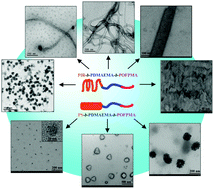This paper is aimed at comparing the effects of flexible and rigid blocks on the morphologies of multicompartment aggregates self-assembled from two kinds of fluorinated ABC triblock terpolymers, in which polyisobutylene (PIB) with a low glass transition temperature (Tg ∼ −67 °C) and polystyrene (PS) with high Tg (∼100 °C) were selected as the flexible and rigid blocks, respectively. The fluorinated triblock terpolymers (abbreviated as PIB-b-PDMAEMA-b-POFPMA and PS-b-PDMAEMA-b-POFPMA, respectively) with similar relative block lengths were synthesized via consecutive oxyanion-initiated polymerization (OIP) of 2-N,N-(dimethylamino)ethyl methacrylate (DMAEMA) and 2,2,3,3,4,4,5,5-octafluoropentyl methacrylate (OFPMA) using pre-functionalized PIB-O−K+ or PS-O−K+ as the macroinitiators. These terpolymers could self-assemble in aqueous solution since the PDMAEMA block is hydrophilic, PIB and PS blocks are hydrophobic, while the POFPMA block is both hydrophobic and lipophobic. The self-assembly behavior was analyzed by transmission electron microscopy (TEM). It has been demonstrated that PIB-b-PDMAEMA-b-POFPMA with the flexible PIB block could self-assemble into four types of reproducible nanostructures with the increase of polymer concentrations, including multicompartment micelles, fiber-like aggregates, nanotubules and rod-like aggregates. More interestingly, a uniform zig-zag pattern was observed on the surface of these rod-like aggregates after the solution was maintained without stirring for one week. In contrast, for the PS-b-PDMAEMA-b-POFPMA system containing a rigid PS block, the similar morphologies were rarely observed, except for spherical, hamburger and flower-like multicompartment nanostructures. The present work reveals that the flexibility or rigidity of the hydrophobic segment as well as the polymer concentration exerts a big influence on both the self-assembly behavior and formation of diversified morphologies.
